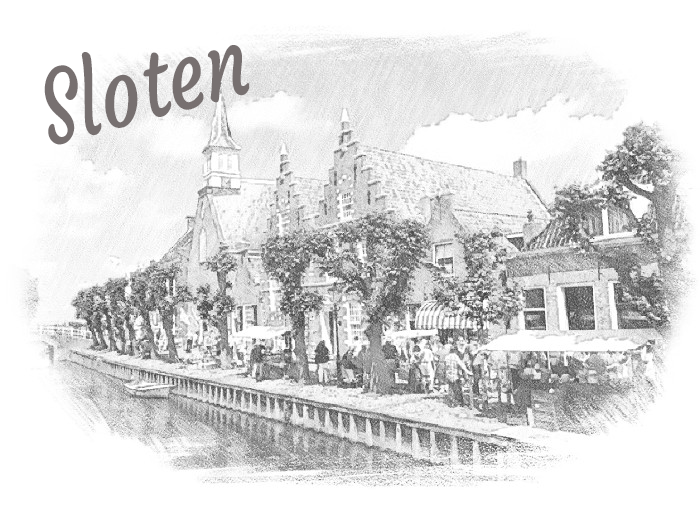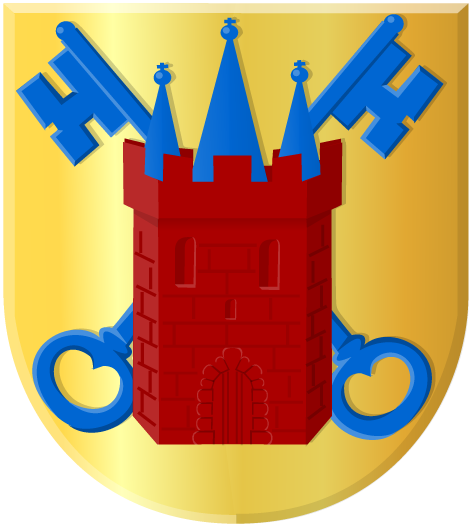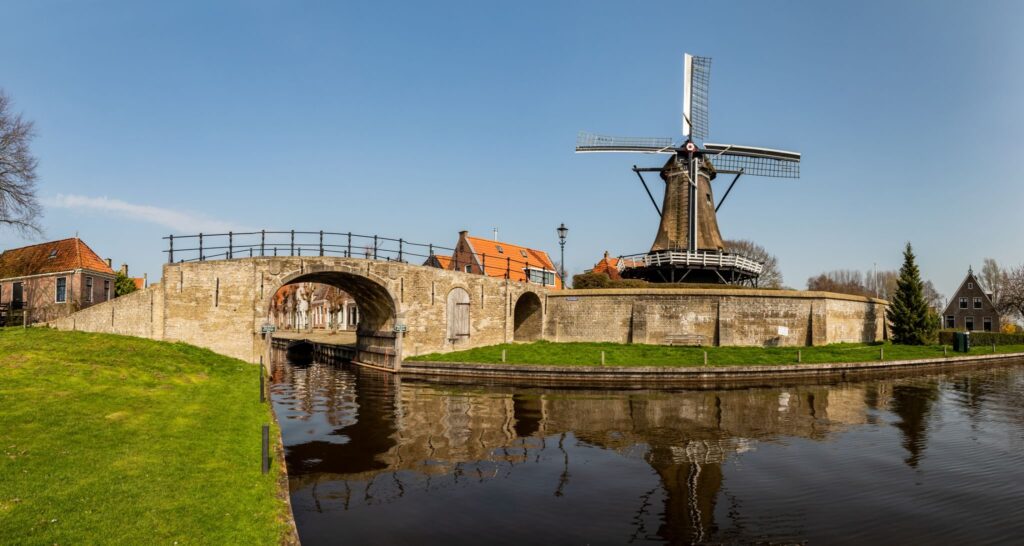
Located in Friesland, Sloten is a city that played a crucial role in defending against invaders in the past. It was once fortified with ramparts, moats, and gates to protect itself from enemies. The 2-kilometer long canals were filled with water from nearby lakes, acting as a natural barrier that separated the city from potential threats. The gates were equipped with watchtowers and drawbridges to regulate entry and keep enemies out, making Sloten a strategic point between North and South Netherlands.
Back in the day, Sloten was an essential contributor in defending the northern part of the Netherlands. To this day, the remains of the city’s fortifications are visible and serve as a spectacular reminder of its storied past. These fortifications stand as a testament to the importance of maintaining historical sites that remind us of our heritage and the sacrifices made by our ancestors to keep us safe. Sloten symbolizes bravery and heroism, making it a site that holds great significance to the people of the Netherlands.
Start your walk from the central square, where the iconic Waterpoort gate stands as a symbol of the village’s history. This gate dates back to the 17th century and offers a great starting point for your exploration. As you pass through the gate, you’ll find yourself immersed in narrow streets lined with well-preserved buildings, some adorned with colorful flowers and traditional Frisian details.
Wander along the canals that crisscross the village, and you’ll likely encounter small boats moored alongside the banks. The reflections of the charming houses in the calm waters create a picturesque scene that’s perfect for capturing memorable photographs.
Continuing your walk, you might come across the Sloten Windmill, a traditional Dutch windmill that adds to the village’s authentic atmosphere. The windmill stands as a testament to Sloten’s agricultural heritage and offers a glimpse into the region’s history.
As you meander through the streets, consider taking a detour to explore the city walls and ramparts. These remnants of Sloten’s defensive past provide a unique vantage point to admire the surrounding landscape, including the Frisian countryside and nearby lakes.
Throughout your walk, you’ll encounter local shops, cafes, and perhaps even a traditional cheese shop where you can sample some of the region’s delicacies. This is a great opportunity to take a break, enjoy some refreshments, and interact with the friendly locals.
As you conclude your walk, you might find yourself back at the central square near the Waterpoort gate. Take a moment to reflect on the beauty and tranquility of Sloten before departing.
Remember to wear comfortable walking shoes and bring a camera to capture the picturesque scenes and moments that make a walk in Sloten, Friesland a truly memorable experience.

de slag om sloten
The battle of slotenSloten, 12 May 1588 In Friesland between the ramparts lies the small town of Sloten. Pier Lupckes from the neighboring village of Tjerkgaast has evil plans to invade Sloten. But he doubts whether the plans he has laid out can succeed, since the city lies within the ramparts and is very well defendable. Together with the Spanish troops of Philip II, Lupckes thinks he has found a way to control the rebellious city. Two skippers from Grouw, Dotte Sibles and Stomme Jelmer, are prepared to set sail in the night of 12 to 13 May 1588. The cargo of their barge consists of beer, so the Spanish soldiers have to stay out of sight of the night watchman. In bad weather, hidden in beer barrels, the barge crosses the Slotermeer towards the small town of Sloten. However, at the last moment the plan leaks out, the ruse is discovered. An observant city guard discovers the Spaniards on board the beer ship and raises the alarm in Sloten. This is followed by a very fierce and bloody battle between the brave city militia and the hostile Spaniards. Skipper Sibles can escape, but Pier Lupckes and Stomme Jelmer have to pay for their betrayal with their deaths. After the trial, they are convicted and the sentence is carried out. No water, no bread and no solitary confinement. 13 Days after May 13, they are publicly beheaded on the spot, after which their heads are ‘exhibited’ on stakes at the gate. This is followed by a very fierce and bloody battle between the brave city militia and the hostile Spaniards. Skipper Sibles can escape, but Pier Lupckes and Stomme Jelmer have to pay for their betrayal with their deaths. After the trial, they are convicted and the sentence is carried out. No water, no bread and no solitary confinement. 13 Days after May 13, they are publicly beheaded on the spot, after which their heads are ‘exhibited’ on stakes at the gate. This is followed by a very fierce and bloody battle between the brave city militia and the hostile Spaniards. Skipper Sibles can escape, but Pier Lupckes and Stomme Jelmer have to pay for their betrayal with their deaths. After the trial, they are convicted and the sentence is carried out. No water, no bread and no solitary confinement. 13 Days after May 13, they are publicly beheaded on the spot, after which their heads are ‘exhibited’ on stakes at the gate.
Sloten is a small historic town located in the province of Friesland in the Netherlands. It holds the distinction of being the smallest city in the country, with city rights granted to it in the late 14th century. The history of Sloten is intertwined with the broader history of Friesland and the development of the region.
Early History: The origins of Sloten can be traced back to the medieval period. It emerged as a settlement due to its strategic location near a waterway known as the Slotermeer, which was an important route for trade and transportation. The settlement grew around a fortress built to provide protection and control over this waterway. The name “Sloten” itself is derived from the Dutch word “sluit” which means “lock” or “dam,” reflecting its role in managing water levels.
City Rights and Growth: In 1426, Sloten was granted city rights by the Frisian ruler Albert of Saxony. These rights allowed the town to hold regular markets, establish its own local government, and engage in various economic activities. The city’s strategic position on waterways contributed to its growth as a trading center and a hub for waterborne commerce.
Fortifications: To defend itself against potential threats, Sloten was fortified with walls, gates, and defensive structures. These fortifications helped protect the town during times of conflict and added to its medieval charm. Some remnants of these historical defenses can still be seen in the town today.
Economic Activities: Sloten’s economy revolved around trade, fishing, and crafts. The town’s location near water bodies allowed it to engage in maritime trade, contributing to its prosperity. Craftspeople, such as blacksmiths and carpenters, played a vital role in the local economy. The town’s marketplace also hosted regular markets where goods were bought and sold.
Decline and Modern Era: As the transportation and trade routes evolved over time, Sloten’s significance as a trading hub diminished. The industrialization of the region and changes in transportation methods had an impact on the town’s economy. However, its historical and cultural value was recognized, leading to efforts to preserve its heritage.
Today, Sloten remains a picturesque town with well-preserved historical buildings, canals, and a charming town center. It attracts tourists interested in experiencing the ambiance of a small medieval city. The town’s rich history is celebrated through local museums, events, and guided tours.
Overall, the history of Sloten reflects the ebb and flow of historical circumstances, from its medieval origins as a fortress settlement to its role as a trading center, and eventually to its current status as a well-preserved historical gem in Friesland.


In its existence as an independent municipality, the Frisian municipality of Sloten had two municipal coats of arms. The first coat of arms of Sloten was confirmed by decision of the Supreme Court of Nobility on March 25, 1818. An investigation in the early 20th century showed that the colors in the 1818 coat of arms differed from the original colours, prompting the municipal council to request a color restoration of its coat of arms. This was granted by Royal Decree on March 18, 1918 From 1984, the coat of arms is no longer in use because the municipality of Sloten was merged into the municipality of Gaasterland, which was renamed Gaasterland-Sloten on 6 July. After the merger, the key from the Sloten coat of arms was included in the coat of arms of Gaasterland-Sloten.











